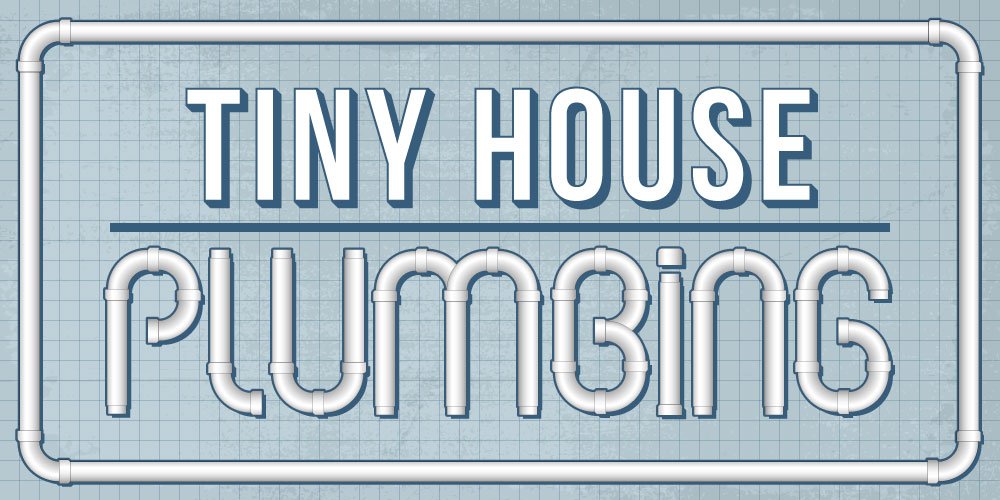
Plumbing in a tiny house can seem daunting at first — I know when I built my tiny house it seemed that way. But what I came to realize after learning a few tricks about how plumbing works in a tiny house is that it wasn’t as hard as it first seemed.
So in this guide, I wanted to lay out how to install pluming in your tiny house, how to connect things like a shower, sink, and toilet, and considerations around water tanks if you want to take your tiny house on the road. I’ll also dig into some of the costs to install plumbing into a tiny house as a DIYer and if you decide to hire a plumber.
How Does Tiny House Plumbing Work?

There are three main differences between a traditional house and a tiny house when it comes to plumbing: how the water comes into the house, dealing with a trailer, and the optional on-board water tank.
The great thing about tiny houses is that because your home is so small, you don’t need any long runs.If you design it right, the plumbing can be super easy to execute. Take time to plan ahead so that you don’t overcomplicate things.
Much like a traditional home, you’re going to have your water supply come into the house, then it usually forks, one line to the hot water heater, the other direct to your sink and shower. The line coming out of the hot water heater will then be your hot supply to your sink and shower.
I’ll give more details on this below.
Tiny House Plumbing Diagram

If you’re anything like me, you need to see a general layout of how all the pipes and drains are laid out and connected in your tiny house plumbing system. Here is a diagram I put together of my tiny house’s plumbing system.
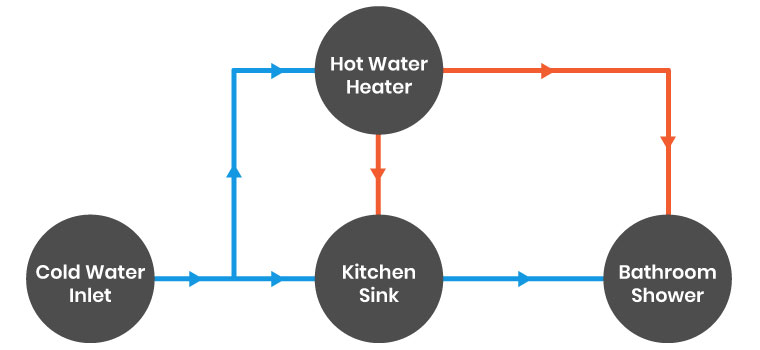
Hot and Cold Water Lines
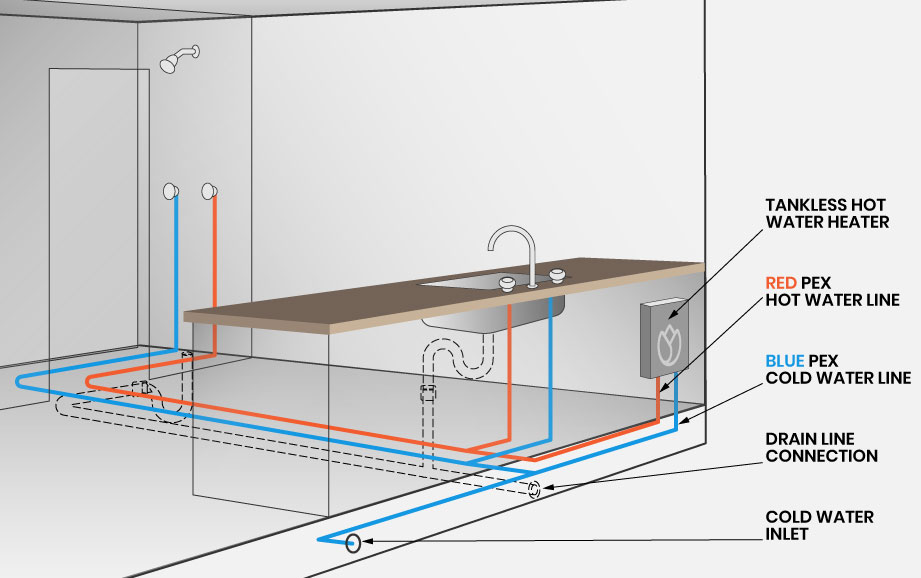
Drain Lines
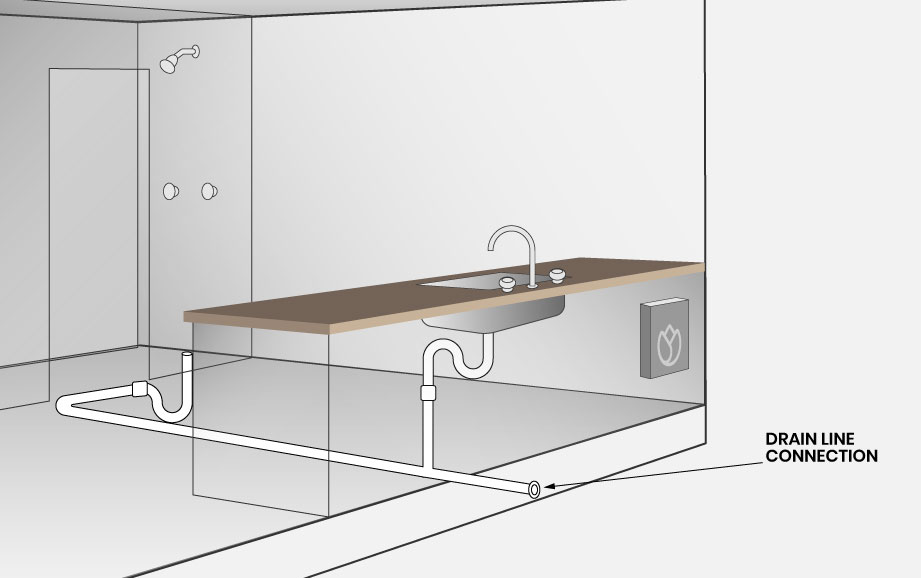
All my water supply lines were made out of PEX, which I color coded. I purchased a roll of red PEX line for hot water and my cold water line was blue colored PEX. This helped me keep things straight in my head. All my drain lines were 2”PVC pipes.
As you can see, the water enters my house near the tongue of my tiny house trailer. The line splits here, with the cold line going directly into my house from the bottom and the other line going up to my tankless hot water heater, which is mounted on the outside.
The cold water line entered into my house behind my kitchen cabinets where it T’ed off. The water line to the left went to the cold water line for the shower. The line to the right followed the wall, turned the corner and came up to feed it’s way to my sink.
The hot water followed a similar path right next to the cold water line using red PEX line.
Drain lines come down in two places: one under my shower, the other from my kitchen sink. Both of these drop through the floor, through my trailer and hang just below the bottom of my trailer. They are connected into one drain line so I have one central point where the water comes out the side. It can then be connected to a septic or RV sewer line connection.
PEX Plumbing Makes Tiny House Plumbing Easy

For many years we used copper and PVC lines for plumbing which were complicated to connect and would split at the slightest sign of freezing. Today, modern plumbing has brought in the use of PEX, and for us tiny house folks, this is a god send.
PEX is the name for Cross-Linked Polyethylene water lines. This stuff is awesome: pretty inexpensive, super easy to work with, can withstand freezing temperatures, and is perfect for the DIYer. It’s risen in popularity over the past few decades and is now the staple of any new plumbing system.
 The great part about PEX is that it’s super easy to connect with quick-connect fittings. These fittings allow you to cut your PEX tubing, clean up the ends, push it into the fitting, and lock it into place with a water-tight connection. Gone are the days of sweating a copper pipe to add flux, and you can forget about gluing up PVC.
The great part about PEX is that it’s super easy to connect with quick-connect fittings. These fittings allow you to cut your PEX tubing, clean up the ends, push it into the fitting, and lock it into place with a water-tight connection. Gone are the days of sweating a copper pipe to add flux, and you can forget about gluing up PVC.
Quick connectors or “push fittings” are often referred to as “Shark Bites” (a brand name of a popular quick connector) and they are amazing. You literally just take the pipe and push it in and small metal teeth grip the pipe to create a water tight seal.
What’s even better is that if you make a mistake, you just use a little magnet to quickly disconnect the fitting with ease. Most quick connectors will also allow you to connect PEX lines to other types of lines: copper, PVC, etc.
The PEX line itself comes in several sizes, colors and lengths. Typically, new homes are plumbed with ¾” PEX, but my house was ½” line. PEX tubing can be bought just about anywhere. At the time of writing this post, I can buy two rolls of 50-foot PEX (one blue and one red) for around $50 online or about $60 at your local big box hardware store. That will be more than enough to do your tiny house.
 As mentioned before, you can purchase colored lines to help you color code your water lines as you route them through your house — usually blue for the cold supply lines and red for the hot supply lines. There is no difference between the colors, people just use them to make it easy to identify different lines.
As mentioned before, you can purchase colored lines to help you color code your water lines as you route them through your house — usually blue for the cold supply lines and red for the hot supply lines. There is no difference between the colors, people just use them to make it easy to identify different lines.
The last thing you should know about PEX is that, unlike other water line options, you can actually bend it around corners. There are limits to this of course, as you don’t want to kink the PEX line. For ¾” PEX line, you’re not supposed to bend it more than 7” in diameter. That doesn’t usually mean much to people, which is why they actually sell PEX bend supports to make sure you get it right.
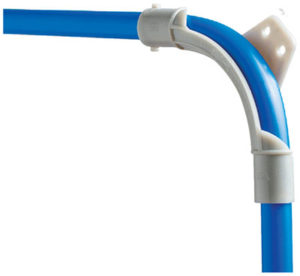

| Tubing Size | Minimum Bend Radius | Minimum Bend Diameter |
|---|---|---|
| 3/8″ | 4″ | 8″ |
| 1/2″ | 85″ | 10″ |
| 5/8″ | 6″ | 12″ |
| 3/4″ | 7″ | 14″ |
| 1″ | 9″ | 18″ |
Minimum recommended bending radius is 8 times the outside diameter of PEX (8 x OD). For 1/2″ PEX with OD of 5/8″, minimum bending radius is 8 x 5/8″ = 5″. Over-bending the PEX pipe, deforms its’ round shape, restricts flow and over-stresses the pipe. Note: minimum bending diameter only refers to the 90-degree and 180-degree (U shaped) bends. Parallel runs of pipe can be spaced as close as necessary.
Tiny House Water Hookups

There are two main ways to hook up water to your tiny house. One is for more longer term, the other is for short term connections if you want to stay mobile. Either method will face one main challenge: freezing as it goes from the water source to your tiny house. Whatever method you use, make sure to insulate it well.
RV Water Inlet

The first method is using a spigot as your water source. Make sure you use a drink safe hose, as a regular hose will leech a lot of nasty chemicals into your drinking water. From the hose, you’re going to want to use an RV water inlet to allow the water to enter your tiny house.
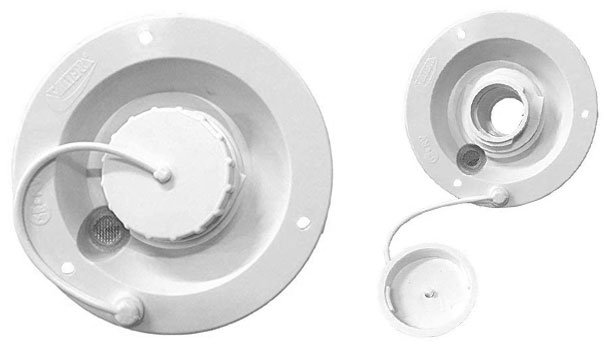
Off the back of this inlet, you can tie in your PEX tubing and run it wherever you need to go.
PROS
- Simple to hook up
- Works at most campgrounds
- Quick to connect and disconnect
- Good on mobile tiny houses
CONS
- More prone to freezing
- Slightly more expensive
- Leaky hose connections common
- Can snag hose and damage inlet
Direct Connection

This is a more permanent method for tiny houses that aren’t as mobile or not mobile at all. I initially started with the above method on my house, but found the hose froze pretty often, even in my moderate climate. Recently, I switched over to having a buried PEX line that came right below my hitch, then brought it up to my house. I added insulation to the PEX line, insulating the small span between the ground and the house.
I also should note that I actually extended my insulation a foot beneath the ground for good measure.
PROS
- Less prone to freezing
- Looks neater on outside
- Cheapest method
- Lasts long term
CONS
- Not meant to be moved
- Needs to be cut if you do move
- Requires you to bury water line
- More technical skill required
Tiny House Water Tanks

Many people want to be able to live in their tiny house while traveling around or live off the grid in their tiny house. A water tank is a great way to make your tiny house more livable when you don’t have a direct connection.
The average American uses around 100 gallons of water per day, so if you’re going to use a water tank as your primary water source, you’re going to have to adjust your relationship with water in a big way. After living in my tiny house for years, I’ve averaged out to around 11 gallons per day.
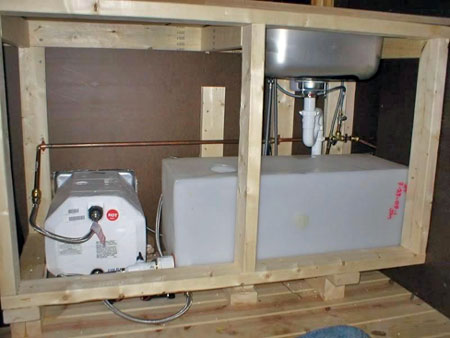 You’ll need water to cook with, take a shower, wash your dishes, drink and general cleaning tasks. It can add up quickly when you remember that water is 8 lbs. a gallon. I like the option of having a tank, but realistically, you’re going to need a reliable water source from a well or city connection.
You’ll need water to cook with, take a shower, wash your dishes, drink and general cleaning tasks. It can add up quickly when you remember that water is 8 lbs. a gallon. I like the option of having a tank, but realistically, you’re going to need a reliable water source from a well or city connection.
The biggest tank I’ve seen in a tiny house was around 80 gallons, which accounts for 640 extra pounds of weight on your trailer. What is more, you can’t just have your tank on one side of your trailer or your weight will be distributed unevenly side to side.
You also want your tank to be located directly over your axels, if at all possible. This is because too much weight on the tongue or in the rear (lifting up at the tongue) can be very dangerous. Properly balancing the load on your trailer is critical, and that can be difficult when a water tank is involved. Water tanks can also slosh, throwing around the weight. Your load and calculations need to take into account that your water tank will get lighter as you use water, too.
You have two options to pump water from a storage tank to your sink.
12 Volt Sink Pump From Water Tank

This is the more advanced option, where you’ll have a 12-volt pump that draws water out from your tiny house water tank and up to your sink faucet. This option usually is only good for cold water, because you’d have to draw so much water through your lines and hot water heater that you’d waste a lot of water waiting for hot water to come through.
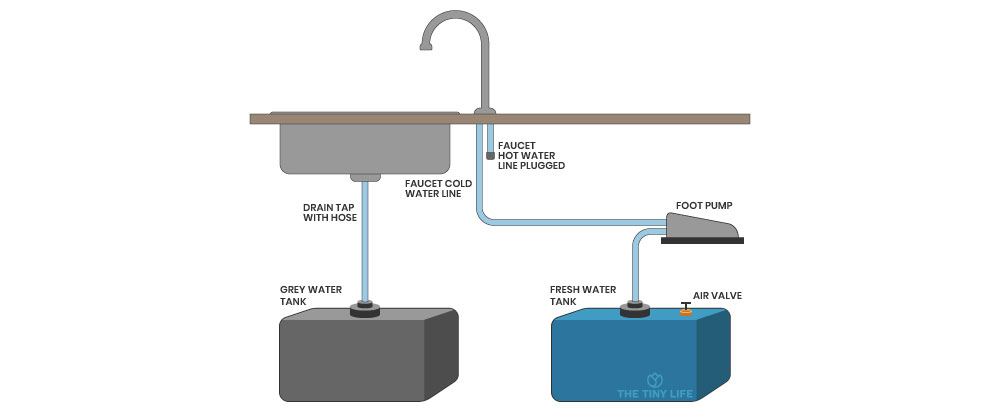
Simple Foot Pump Sink From Water Tank


For those who don’t want to get into complicated 12-volt pumps, a foot pump can be a really great option. This is a dead simple system that only requires a few connections and a few parts.
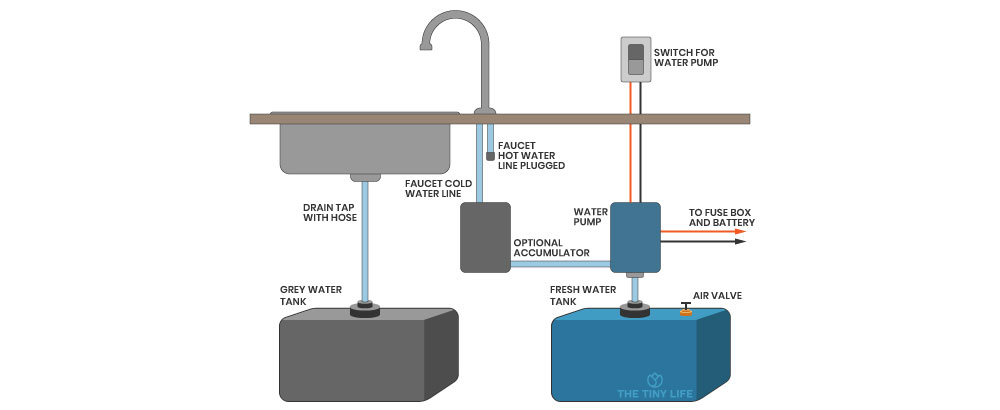

How Much Does It Cost To Put Plumbing In A Tiny House?


Plumbing your tiny house doesn’t cost a whole lot unless you hire a plumber. Luckily, PEX makes this very approachable and your drain lines, which will be PVC, are going to be very short runs. If you’re able to avoid hiring a plumber, then you can save big. If you do end up hiring a plumber, expect to pay anywhere between $100-$200 an hour for their work, plus materials.
Here is an example of plumbing costs from my tiny house build:
- 25-foot roll of RED PEX: $13.78
- 25-foot roll of BLUE PEX: $13.78
- Five right-angle elbow push fittings: $51.40
- One Tee-style push fitting: $13.45
- Name brand shower faucet: $89.95
- Name brand kitchen faucet: $105.95
- 20 feet schedule 40 PVC drain line: $11.56
- PVC assorted fittings: $3.48
- Sink P trap: $8.37
- Shower P trap: $4.38
- PVC pipe cement: $8.98
- PEX pipe cutter: $9.71
- PEX deburring tool: $11.56
- Sharkbite removal tool: $1.98
- One bag nail clamp (50 pieces): $12.04
Total Cost To Plumb My Tiny House: $351.39
Other Tiny House Plumbing Costs


I also wanted to share a few things that you might want to factor into your own plans and budget that aren’t included in the above list.
The biggest one, of course, is any labor costs if you hire a plumber. A plumber will cost anywhere from $100-$200 an hour. You can expect about five to ten hours of work for your entire house including your hot water heater, sinks, showers, drain lines, etc.
Not included in my list most notably is any toilets, as I opted for a composting toilet. Going the route of a traditional toilet will add a good bit of work and cost on your part. Not because they are overly difficult or expensive, but because you’ll have to get the city involved to have a flush toilet.
The “tap fee” to tie into the city sewer line and the water line is very expensive. My city charges a whopping $11,582 just to connect to the lines at the street. After that, you’re still responsible for connecting that line from the street to your house, which will run you about $10 per foot for the water line and $15 per foot for the sewer line. Alternatively, you may be able to install a septic system, starting around $5,000.
Another cost I didn’t include here was a water heater. I use a Rinnai v53e tankless hot water heater, which after 5 years, I still love. Having endless hot water when I need it means I can take long hot showers without worry or running out of hot water and not having to account for a lot of extra weight in water storage.
Since I only heat water as I use it, I use propane for this, which is a great option for me because I live off the grid. While I don’t love relying on a fossil fuel (propane), it’s the most practical way for me to heat water off the grid.
The last thing you might want to consider is if you are going to have a bathroom sink, tub, dishwasher or laundry machine. These will all add material costs and labor, so just be sure to account for them in your budget, plans and in calculations for weight!
Tiny House Plumbing Tips


From someone who did a lot of things wrong and a few things right, here are some of my best tiny house plumbing tips for when you build your own tiny house.
The biggest tip I’d give is to have your shower and kitchen sink be as close to each other as possible. If you have the shower on one side of an interior wall and the sink on the other side of that same wall, you’ll save a lot of extra work.
Plan Your System
An hour of planning ahead will save you a ton of time down the road, not to mention a lot of headaches.
Consider Venting
Venting your plumbing system is a big deal, without it your drain lines won’t drain properly. I used an in-line “air admittance vale” which allows air to enter the water line without a full drain going through the roof. These vales are contentious because they can fail, but it worked for my purposes.
Plan Your Drains Carefully
I didn’t do this and, when I went to installe my shower drain line, I discovered a metal beam from my trailer right below where the drain needed to be.
Plan Exhaust Venting
Make sure you have the proper space to vent your exhaust vents for your hot water heater, stove and shower fans. I had a lot of trouble with these because the vent tubes were so big. That lead me to getting an exterior mounted hot water heater, which is designed to be outside and vent directly from the unit to the outside.
Slope Drain Lines Properly
Drain lines need to be sloped in a very specific way — ¼ of an inch per foot. Too shallow of a slope and you’ll have clogs, but too steep and your solids will not drain. Getting this right is very important.
Not Leveling Your Tiny House
If your tiny house isn’t perfectly level, all your drain lines will not be slopped right, leading to clogs. You want to make sure your sinks drain properly and that water won’t pool in them. A properly installed drain line will not work if the whole house is off kilter.
Think About Freezing Lines
You want to take frost prevention seriously. Wherever possible, keep your water lines on the inside of your heated envelope, running the lines within interior walls vs. exterior walls. For the connection from your water source to your tiny house, insulate and use heater tape when possible.
Have A Whole House Shut Off
The best addition to my system was a $5 ball valve to help me turn off my water to the house when I go out of town, need to service my plumbing system, or if a leak were to ever happen.
Always Have Access
Make sure you always have a way to access the water lines in your tiny house. It doesn’t have to be the most convenient access, but if you can always get at your water lines, you can fix any problems that arise.
Carefully Cut And Deburr PEX
Push fittings are great, but you need to make sure your cuts are perfectly straight so that when you push the tubing into the fitting, it seals well. Also use a deburr tool to make sure the cut is perfectly clean.
Don’t Reuse Fittings Or Tubing
If you have to disassemble a fitting for some reason, best practice is to replace the tubing and fitting all together. Many manufacturers will say their fitting can be reused a few times and some folks don’t mind reusing the fittings, but in my mind, buying a new fitting for $5 is good peace of mind.
If you kink your PEX tubing, you should cut a new piece and replace it. Here again, for a few cents a foot, the cost of knowing you won’t have an issue is well worth it.
Tankless Hot Water Heaters Are Your Friend
If you’ve never heard of or had one, tankless hot water heaters are amazing. I ended up with a Rinnai hot water heater and I love it! Tankless hot water heaters essentially take cold water and run it over a heated coil exchanger to heat the water as it passes through the unit. This is great because you’re not heating water when you’re not using it, which is great for being off the grid. You won’t ever run out of hot water, and since it isn’t a tank, you don’t have the bulk or weight of a tank.
Remember That Water Is Very Heavy
Since we are building on a trailer, we need to make sure we take into account the water that’s in our water lines, in our hot water heaters (if we have a tank hot water heater) and in a tiny house water tank.
Water is very heavy, weighing in at around 8 lbs. per gallon. If we have a water tank in our tiny house that holds 50 gallons of water, that’s over 400 lbs! And if our hot water heater has a tank of 40 gallons, that’s 320 lbs. So if you have either of these, you need to work it into your weight calculations for your trailer.
Consider RV Parts
RV’s have a few features around connecting to utilities when at a campground which are very helpful to tiny house folks. Fresh water inlets, access doors, sprayers, RV plugs, etc., all are useful when connecting tiny houses to the grid.
Your Turn!
- What are you planning for in your tiny house plumbing?
- What tiny house water hookup will you use?
- Are you going to have a tiny house water tank?
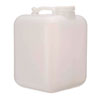


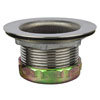
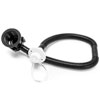
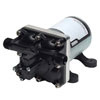
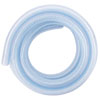
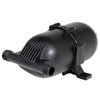
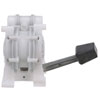
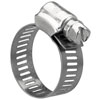

I went to a Tiny House build workshop, so I’m down with the PEX system — it’s awesome. But tell me where I can buy a “Drink-safe” hose. Neither Lowes nor Home Depot carries them last time I checked.
I’ve seen them in walmart with the RV items, lowes, and on Amazon. Any RV / camper store would have them too
Both Lowes and Home Depot carry the drinking water hoses in my area, you may need to have them order it. Search for Marine & RV water hoses, it will show up then.
RV stores have potable water hoses
Did you put a trap under your shower. If so what brand did you use?
There’s no discussion of hooking up a conventional toilet; there seems to be an assumption that the builder will use a composting toilet, which isn’t a given. I’m not sure at my age that I want to deal with the maintenance involved with a composting toilet.
I’m in my 60s and have lived with a composting toilet for 5 years BUT it isn’t the type that is one self contained unit. I have an Envirolet unit that has the composter in the basement. So if you are thinking of having a stationary house, I suggest a basement for storage and utilities. And if you can’t hook up to sewer and don’t want to put in an expensive septic system, this is a good alternative. I clean it out ONCE A YEAR and take out less than a 5 gallon pail of ‘compost’. Still not for the faint of heart (or nose) and if you have more than two people in the house it can be touchy.
Hi there! Very nice blog. Thank you for sharing information regarding tiny house plumbing work. You have shared information on tiny house tanks, diagrams, and costs which is very good. By using a tiny house plumbing option you can connect one to more pipe in an easy way for flow. Keep sharing, keep posting such amazing blogs.
Do you have any insight on disposing of grey water off grid? I was hoping to be able to use something resembling a French drain with my stationary tiny house. (I realise there are considerations based on municipal laws, as not all options are allowed in all areas)
On your disclaimer under the drain line diagram you suggested to hire Electrician rather a professional plumber. Im guessing its a typo mistake. Overall well done explaining. Easy to understand. Keep coming back.🙏
Thank you so much for such wonderful, helpful and clear information! Truly appreciate! 😇🫶I wanted to know about Dding an outside faucet for a garden hose 🤣😁
Great post! this guide offers useful advice for anyone building their own tiny residences and highlights the significance of dealing with water systems with care due to their weight. It’s an excellent resource for anyone interested in the practicalities of tiny house life. If you need professional plumbers, you can easily locate home plumbers near you by clicking on this link: https://proplumberservice.com/mobile-home-plumbers-near-me/
In your article you do not mention hammer arrestors, as I am about to run water lines to my permant foundation tiny home with kitchen sink,vanity, toilet walkin shower with rheem13k REX Instant electric water heater, I am wondering if hammer arrestors are needed near water heater I am using system similar to one you describe my longest run to my kitchen about 9ft.
Do you have hammer arrestors or if not do you have any problems
Concerned about P trap in my tiny house freezing. Can we put it in the interior or are there other options.
If I’m planning for the long term connection rather than the RV connection, how do I end the line? I’m not building where I’ll be living. Do I leave a length of pex sticking out of the house at the inlet?
You do not mention drains here at all. What to do with the gray water from the sink and shower? Thanks